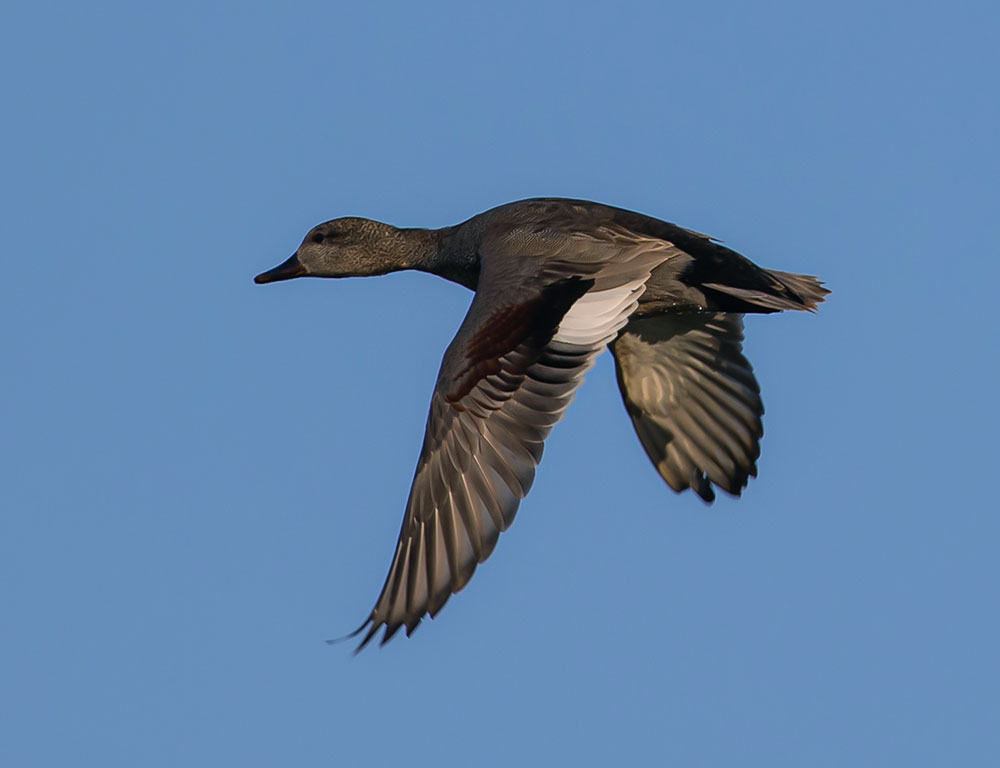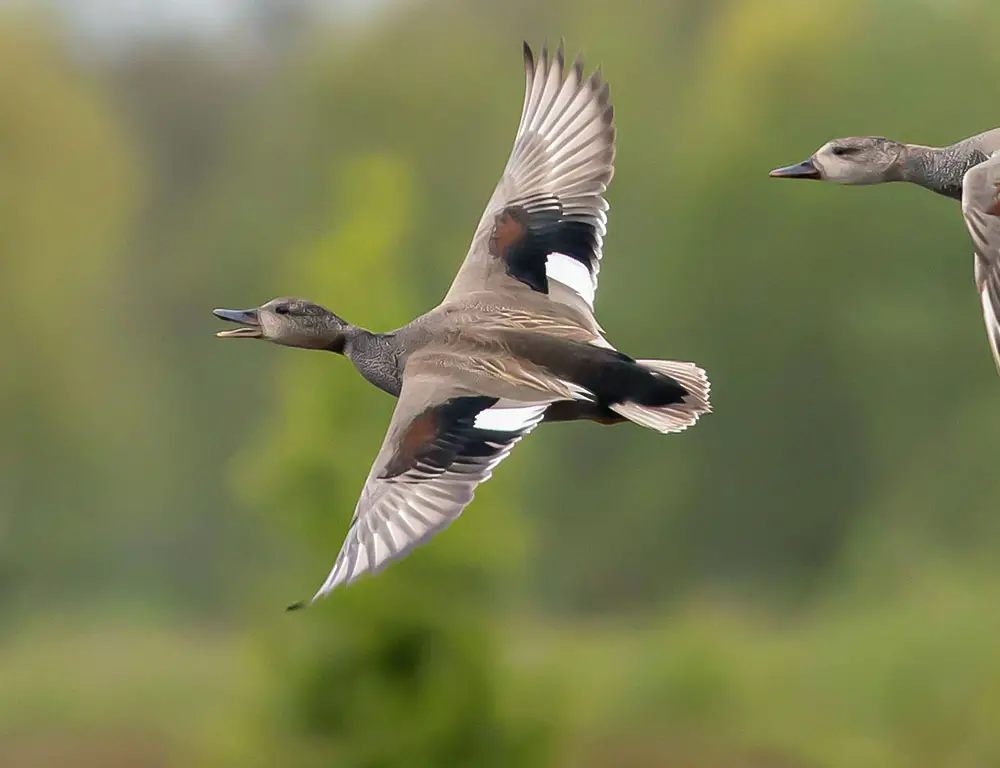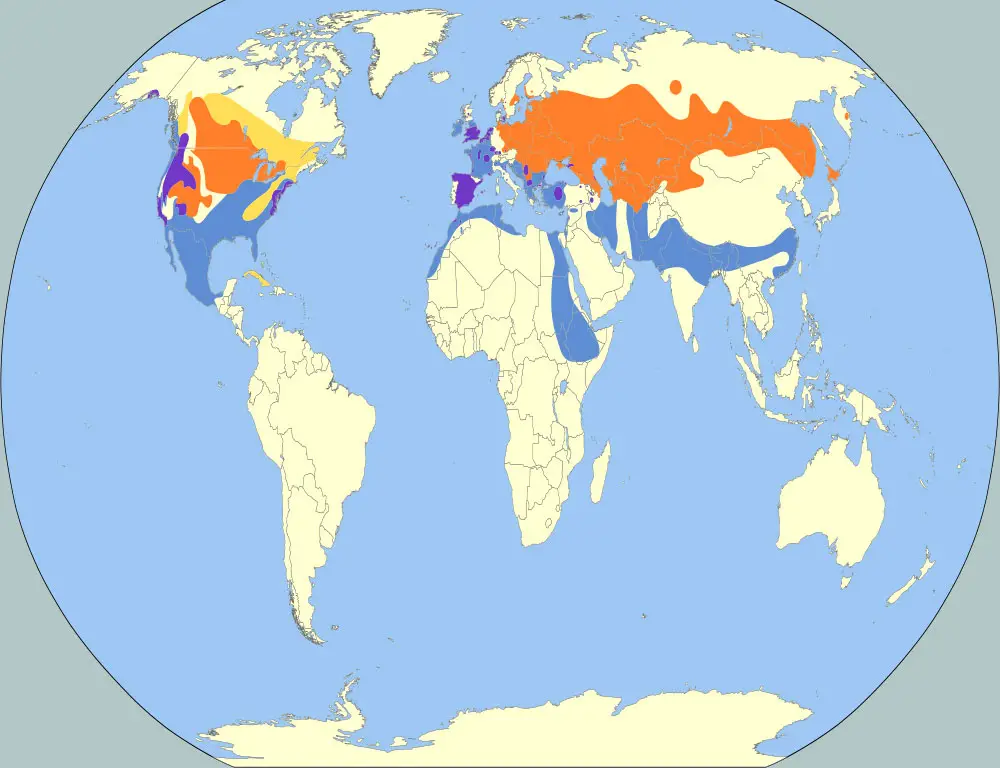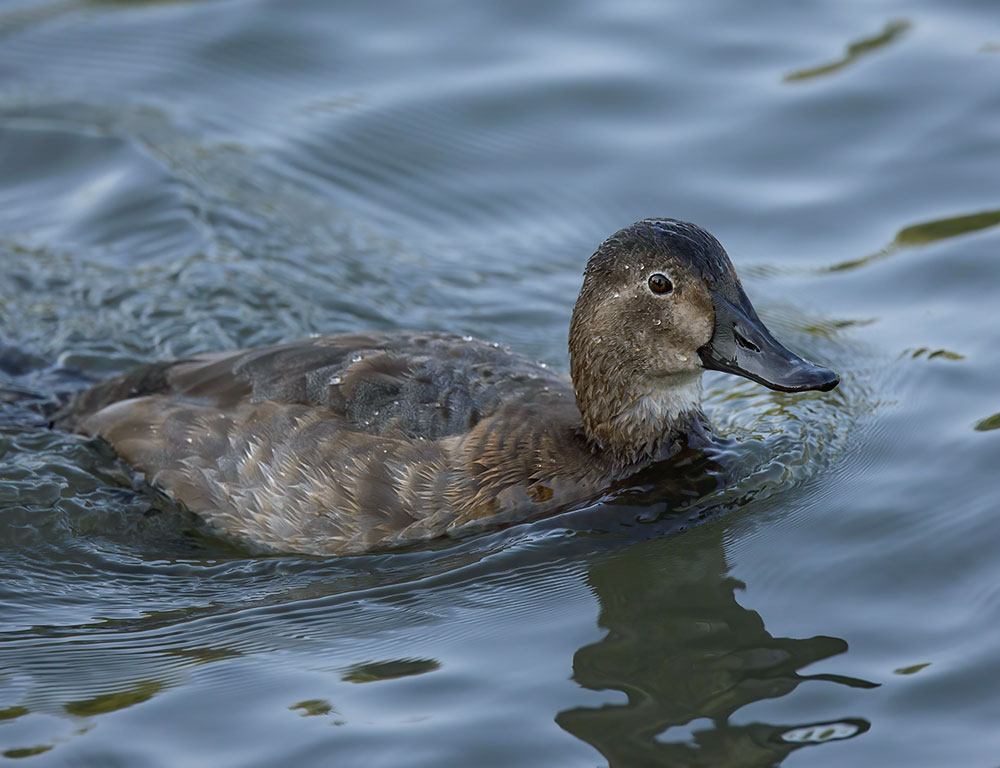The Gadwall (Anas strepera) is a medium-sized dabbling duck across Eurasia and North America, commonly inhabiting shallow wetlands, marshes, and ponds.
Its subtle yet striking plumage is recognized by intricate patterns of gray, brown, and black, with a distinctive white patch on its speculum.
These ducks are known for their secretive nature, often found foraging for aquatic vegetation and small invertebrates in quiet waters.
Although not as conspicuous as other waterfowl species, Gadwalls play a crucial role in wetland ecosystems as seed dispersers and contributors to nutrient cycling.
Their conservation status is currently considered of the least concern, although habitat loss and degradation pose ongoing threats to their populations.

Physical Characteristics of Gadwall
The Gadwall is a visually striking dabbling duck with distinct physical characteristics that aid in its identification.
Here are eight key points to help identify this specific bird:
Size and Shape
The gadwall, ranging from 47 to 58 cm in length and boasting a wingspan of 78 to 85 cm, exhibits slight sexual dimorphism.
Males, weighing approximately 990 g, outweigh their female counterparts by an average of 140 g, as females tip the scale at around 850 g.
They have a relatively slim body, with a rounded head and a moderately long, broad bill, compared to other dabbling ducks.
Plumage
Subtle yet intricate patterns characterize the plumage of Gadwalls. Males, known as drakes, exhibit a mottled gray-brown body with black barring on the back and sides.
They have a distinctive black patch on the rump, bordered by white. The head is grayish-brown with a darker crown and a white throat. Females, or hens, have a mottled brown body with darker streaks and a more minor white patch on the wing.
Speculum
One of the most distinctive features of Gadwalls is their speculum, or wing patch. In flight, males and females display a prominent white speculum bordered by black and chestnut.
Bill Color
The bill of Gadwalls is typically dark gray to black, with a slightly upturned shape. This bill is adapted for dabbling, allowing the duck to filter food from the water’s surface.
Legs and Feet
Gadwalls have relatively long legs and webbed feet, adapted for swimming and foraging in shallow waters. Their legs and feet are a dull orange or yellowish color.
Behavior
While foraging, Gadwalls often tip up their bodies to reach aquatic vegetation and small invertebrates in shallow waters. They are typically seen in pairs or small groups and are more secretive compared to some other dabbling ducks.
Habitat
Gadwalls can be found in various wetland habitats, including marshes, ponds, lakes, and flooded fields. They prefer shallow, quiet waters with plenty of vegetation for cover and feeding.
Voice

The vocalizations of Gadwalls are relatively quiet compared to other waterfowl species. They produce soft quacking sounds, often described as nasal or raspy.
Identifying Gadwalls involves observing their size, shape, plumage patterns, speculum, bill color, leg and foot color, behavior, habitat preferences, and vocalizations.
By paying attention to these critical characteristics, birdwatchers can confidently distinguish Gadwalls from other duck species in their environment.
Taxonomy of Gadwall
The table outlines the taxonomic details of the Gadwall (Mareca strepera), a bird species. It delineates its classification from domain to species, categorizing it under Eukaryota, Animalia, Chordata, Aves, Anseriformes, Anatidae, and the genus Mareca.
| Taxonomic Level | Classification |
| Domain | Eukaryota |
| Kingdom | Animalia |
| Phylum | Chordata |
| Class | Aves |
| Order | Anseriformes |
| Family | Anatidae |
| Genus | Mareca |
| Species | Mareca strepera |
The Gadwall (Mareca strepera) species encompasses multiple subspecies, including the nominate subspecies M. s. strepera and the extinct M. s. couesi, also known as Coues’s Gadwall. M. s. strepera represents the common Gadwall found across its range.
This subspecies is characterized by its distinctive plumage and typical habitat preferences, thriving in wetlands and shallow waters across Eurasia and North America.
On the other hand, M. s. couesi, named after American ornithologist Elliott Coues, once inhabited Teraina, a coral atoll in the Pacific Ocean, but became extinct around 1874.
The extinction of Coues’s Gadwall underscores the fragility of island ecosystems and the impact of human activities on vulnerable species.
Studying the history and characteristics of both subspecies provides valuable insights into the evolution, distribution, and conservation of the Gadwall species as a whole.
Gadwall Life History
The Gadwall (Mareca strepera) is a fascinating dabbling duck known for its subtle yet striking plumage and secretive nature. Understanding its life history provides insights into its ecological role and conservation needs.
Food
Gadwalls are omnivorous, feeding primarily on aquatic vegetation, seeds, and small invertebrates.
Their diet includes seeds of sedges, grasses, aquatic plants, insects, snails, and crustaceans. They forage by dabbling in shallow waters, tipping up their bodies to reach food beneath the surface.
Range Map

Gadwalls primarily breed across the central plains of the United States and Canada, favoring wetlands and marshes.
During winter, they migrate southward, frequenting the central and southern regions of the United States as well as extending their range into Mexico.
Their adaptability ensures a broad distribution across North America.
Nesting
Gadwalls typically build their nests on the ground, concealed among dense vegetation near water bodies.
The female constructs the nest using grasses, reeds, and other plant materials, lining it with down feathers for insulation. Nest sites are chosen for their proximity to suitable foraging areas and protection from predators.
| Nesting Details | Description |
| Clutch Size | 7-10 eggs |
| Number of Broods | Typically one brood per breeding season |
| Egg Length | Approximately 5.4 centimeters (2.1 inches) |
| Egg Width | Approximately 3.7 centimeters (1.5 inches) |
| Incubation Period | 24-28 days |
| Nestling Period | 40-50 days |
Breeding
Breeding season for Gadwalls occurs in spring and early summer. Males court females through displays and calls, forming monogamous pairs for the breeding season.
After mating, the female lays a clutch of 7-10 eggs, which she incubates for about 24-28 days. Both parents participate in caring for the ducklings after hatching.
Diseases
Gadwalls may be susceptible to various diseases and infections, including avian influenza, botulism, and avian cholera. These diseases can impact individual birds and entire populations, particularly in densely populated wetland areas.
Treatment
Treatment for diseases in Gadwalls often involves monitoring and management efforts to control outbreaks and prevent the spread of infections.
This may include vaccination programs, habitat management, and disease surveillance measures implemented by wildlife agencies and conservation organizations.
Conservation Status
The gadwall holds a status of least concern on the IUCN Red List, indicative of its stable population and widespread distribution.
Recognized under the Agreement on the Conservation of African-Eurasian Migratory Waterbirds (AEWA), efforts are in place to safeguard their habitats and migration routes.
Conservation initiatives aim to sustain healthy populations of this species, ensuring its continued presence across its range.
10 Behavioral Habits of Gadwall

The Gadwall (Mareca strepera) is a dabbling duck species known for its subtle elegance and intriguing behaviors.
Here are 10 behavioral habits of Gadwalls:
1. Dabbling Feeding Behavior
Gadwalls exhibit dabbling behavior, tipping up their bodies to forage on aquatic vegetation, seeds, and small invertebrates in shallow waters.
2. Social Structure
Gadwalls are often seen in pairs or small groups during the breeding season. They may form larger flocks outside of breeding, particularly during migration and wintering periods.
3. Courtship Displays
During the breeding season, male Gadwalls perform courtship displays to attract females.
4. Monogamous Pairing
Gadwalls form monogamous pairs for the breeding season. Males and females engage in cooperative behaviors such as nest building, incubation, and caring for ducklings after hatching.
5. Territorial Behavior
Male Gadwalls may exhibit territorial behavior to defend nesting sites and mates from intruders. This behavior is often displayed through aggressive posturing and vocalizations.
6. Migratory Patterns
Gadwalls undertake seasonal migrations between breeding and wintering grounds. They may travel long distances, following traditional migration routes to access suitable habitats and food resources.
7. Vocalizations
Gadwalls produce a variety of vocalizations, including soft quacks, whistles, and grunts. These vocalizations are used for communication within flocks, during courtship displays, and to alert others to potential threats.
8. Feeding Synchronization
Gadwalls often synchronize their feeding movements when foraging in groups.
9. Nocturnal Feeding
Gadwalls may engage in nocturnal feeding behavior in some habitats, particularly in areas with high human disturbance during daylight hours.
10. Agonistic Interactions
Gadwalls may engage in agonistic interactions, particularly during the breeding season when competition for mates and resources is heightened.
Wrap Up
The gadwall (Anas strepera) emerges as a resilient and adaptable waterfowl species, thriving across diverse wetland habitats of North America.
With its characteristic mottled plumage and distinctive silhouette, this duck species plays a vital ecological role as both a predator and prey, contributing to wetland biodiversity.
While facing minimal conservation concerns and holding a status of least concern on the IUCN Red List, the gadwall benefits from international agreements such as the Agreement on the Conservation of African-Eurasian Migratory Waterbirds (AEWA), which underscores the importance of safeguarding its migratory routes and habitats.
However, continued vigilance is essential to mitigate potential threats such as habitat loss, pollution, and climate change, ensuring the long-term sustainability of gadwall populations.
Through collaborative conservation efforts and habitat management, we can secure a future where the gadwall continues to grace wetlands with its presence, enriching ecosystems and captivating bird enthusiasts worldwide.